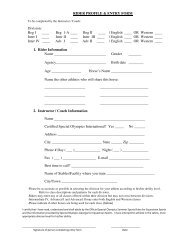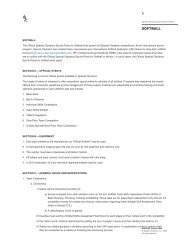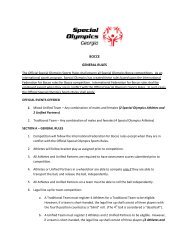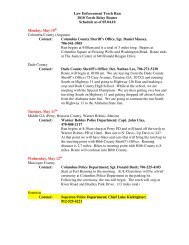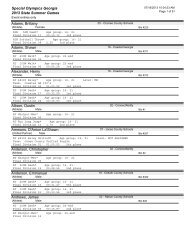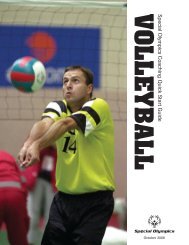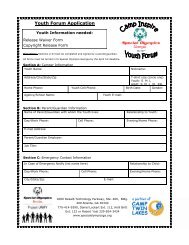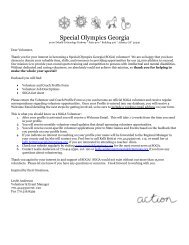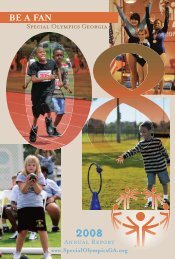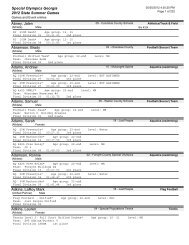Athletics Quick Start Guide - Special Olympics
Athletics Quick Start Guide - Special Olympics
Athletics Quick Start Guide - Special Olympics
You also want an ePaper? Increase the reach of your titles
YUMPU automatically turns print PDFs into web optimized ePapers that Google loves.
<strong>Special</strong> <strong>Olympics</strong> <strong>Athletics</strong><br />
Coaches <strong>Quick</strong> <strong>Start</strong> <strong>Guide</strong><br />
Relays<br />
Relays in athletics are the time when athletes get to come together as a team. Relay racing is the art of running with a<br />
baton and passing it from one teammate to the other, and making three exchanges with the fourth runner crossing the<br />
finish line with the baton.<br />
The most difficult concepts to instill in relay athletes are running away from someone while trying to receive<br />
something from that person, and passing within the “zone.” The ultimate goal of the relay is to move the baton around<br />
the track and across the finish line in the fastest way possible without getting disqualified.<br />
Coaches need to incorporate relay passing into daily conditioning exercises. The coach may find that some athletes<br />
are better at handing off than receiving a baton. Place the athletes accordingly. The lead-off runner only has to hand off,<br />
but must be consistent at getting a legal start. The second and third runners have to both hand off and receive the baton.<br />
The fourth runner only receives the baton but must know how to effectively finish a race.<br />
The <strong>Special</strong> <strong>Olympics</strong> relay races include the 4x100-meter and the 4x400-meter, which can also be called 400m and<br />
1600m relays.<br />
4 x 100m Relay<br />
All runners in the 4x100m relay must stay in their designated lanes the entire race.<br />
Leg Baton Ability Athlete Strengths<br />
Lead-off Leg Passes baton • Good starter, with good acceleration and<br />
balance<br />
• Can run the curve, staying in the lane<br />
Second Leg<br />
Third Leg<br />
Receives baton<br />
Passes baton<br />
Receives baton<br />
Passes baton<br />
• Very fast runner<br />
• Ability to run strong straightaway<br />
• Excellent speed and endurance<br />
• Can run the curve, staying in the lane<br />
Fourth Leg or<br />
“Anchor” Leg<br />
Receives baton • Most competitive runner<br />
• Ability to catch and pass runners<br />
Teaching Relay<br />
Holding baton<br />
Grasp one end of the baton with the fingers around the baton and thumb lying on top of it.<br />
<br />
When teaching how to hold, use a piece of tape around the baton, indicating where the athletes should grasp the<br />
baton.<br />
Receiving baton<br />
Identify the 20m exchange zones with athletes.<br />
Stand just inside the zone.<br />
<br />
<br />
Have power foot forward (see <strong>Start</strong>s Section).<br />
Hold recovery hand back. Receiving hand depends on what type of exchange is chosen.<br />
<strong>Athletics</strong> <strong>Quick</strong> <strong>Start</strong> <strong>Guide</strong>- September 2007 29




